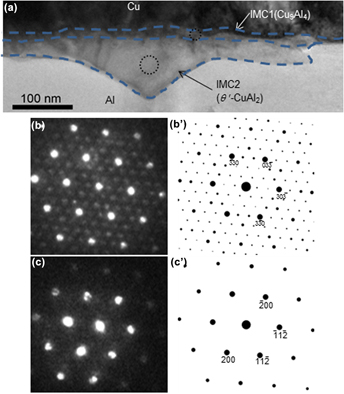Article contents
Comprehensive transmission electron microscopy study on Cu–Al intermetallic compound formation at wire bond interface
Published online by Cambridge University Press: 25 November 2014
Abstract

Comprehensive intermetallic compound phase analysis at wire bond interfaces was performed for a side-by-side comparative study between 18 µm Pd-only coated Cu wire and 18 µm Pd-coated Cu wire followed by Au flash coating. Scanning electron microscopy and transmission electron microscopy results combined with nanobeam electron diffraction and structure factor calculation identified the formation of metastable θ′-CuAl2 and Cu9Al4 in both of the wire bonds before and after high temperature storage test. In particular, nanobeam electron diffraction and structure factor calculation unambiguously revealed that the two intermetallic compound phases grow in size after high storage temperature test in a manner that they maintain their epitaxial relationships that minimize lattice mismatch at the Cu/Al wire bond interface. Nanobeam electron diffraction and energy dispersive x-ray spectroscopy results found no significant Au flash coating effects in terms of intermetallic compound morphology, phase, and thermal evolution.
Keywords
- Type
- Articles
- Information
- Copyright
- Copyright © Materials Research Society 2014
References
REFERENCES
- 4
- Cited by


